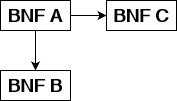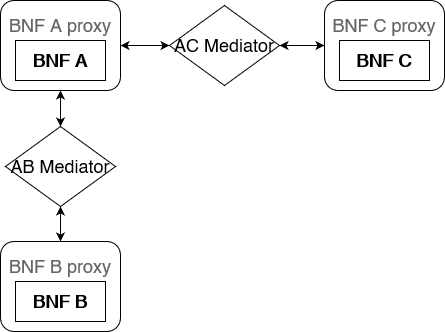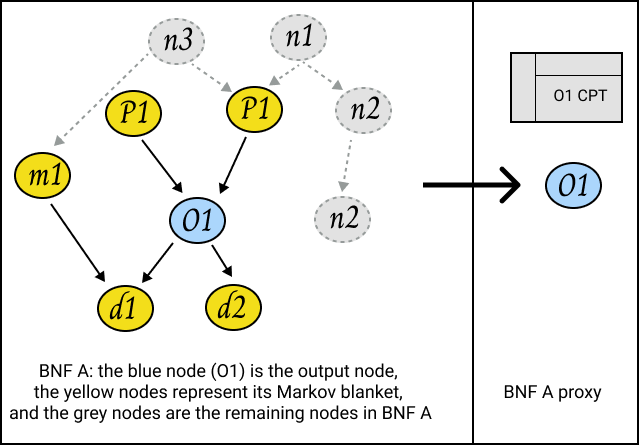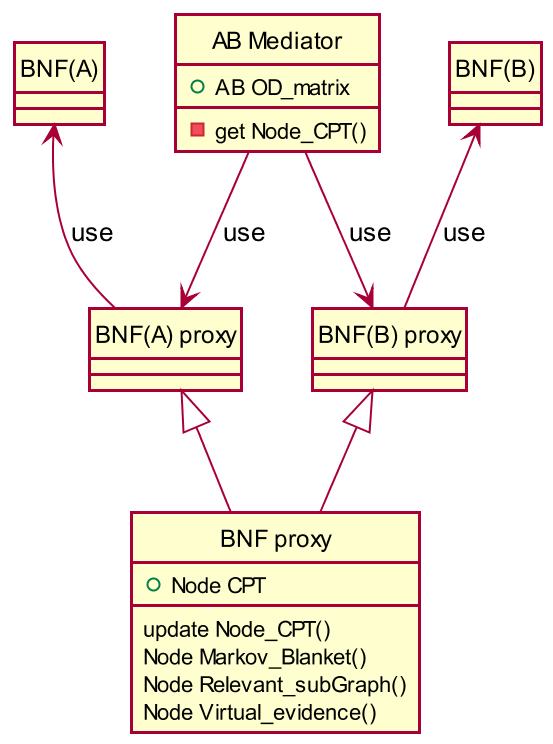BNFs linking
Version: 1.0.0
Pattern language family: OOP
Modeling phase:
2. The conceptualization phase of a system of interest
Modeling step:
3. Conceptualization of the system, specification of data and other prior knowledge
5. Choice of how model structure and parameter values are to be determined
Problem:
How to achieve loose coupling between OOBN fragments and maintain high abstraction of each BNF?.
Solution:
The concept of encapsulation in OOP can be thought about as hiding some entities data, implementation, design details, and instantiation rules. This can increase the model components’ reusability as well as increasing the model’s composability. Encapsulation in an OOBN entails that each of the BNFs included in the model can be instantiated using a different method, i.e. some using CPT and structure learning while others utilize expert knowledge, or that a certain BNF class can have different instantiations and each of the resulting BNFs can be plugged into the model without having to do major changes to the other BNFs.
Two OOP design patterns can be combined together in order to achieve encapsulation and loose coupling in OOBNs, namely: the Mediator pattern and the Proxy pattern. Mediator is a pattern that is used to reduce the dependencies between objects by restricting the communications between them and only allows the communication to happen through a mediator, thereby help in achieving loose coupling between objects. Proxy on the other hand, is a pattern that control access to objects by providing a substitute or a placeholder for them that only contains part of their functionality. The proxy object provides an interface for an object that is expensive to operate.
In an OOBN context, a mediator object is created for each couple of interacting BNFs. That mediator object takes the origin-destination mapping between the two BNFs as an input, this is an artifact that defines which nodes in the first BNF are connected to which nodes in the second BNF. For each of the origin and destination BNFs, a proxy BNF is created which only contains the origin output nodes, and the destination input nodes. The mediator object uses the proxy nodes to read the origin output nodes and connect them to the destination input nodes and perform any necessary forward or backward CPT updating. The simplified proxy BNFs are far less complex than the original BNFs and exposes only the output and input nodes which reinforces the BNFs encapsulation.
Applying this pattern enables the modeler to decompose large networks into smaller BNs called BNF. Each abstract BNF encapsulates a common concept, and the instantiation of the BNFs defines implementation variations. This approach enables modelers to reinforce the component-based structure of the OOBN while conforming with the encapsulation and abstraction OOP concepts.
Structure: The solution proposed by this pattern have the following structure:
- Consider an OOBN composed of three BNFs; A, B, and C.

Fig.1 Three abstract BNFs representing the components and structure of the system to be modeled.
-
First, we determine the input-output mapping that defines how each pair of BNFs are connected together. In this case we should have two mappings, one that connects BNFs A and B, and another connecting BNFs A and C.
-
a mediator object is added to the OOBN for each link between each pair of BNFs, i.e. we should have two mediators; AB mediator and AC mediator.
-
Additionally, a proxy BNF is created for each BNF in the OOBN. The proxy BNF is a simplified BN that contains only the relevant input or output nodes based on the OOBN structure. Here, BNF A proxy will contain the output nodes from BNF A. BNFs B and C proxies will contain the input nodes in B and C respectively as shown in the following figure.

Fig.2 Combining the Proxy and Mediator patterns to connect the BNFs.
- The Proxy BNF is created by copying the output/input nodes and their respective CPTs. If the prior CPT for the output/input nodes is available, this will be sufficient to perform the inference between the proxy BNFs, otherwise the proxy BNFs can make use of the Markov blanket for each output/input node to do the inference.

Fig.3 Implementation of the proxy pattern.
-
The class diagram for the Mediator object and the proxy BNFs and their interactions appears in the figure below. The mediator uses the OD-matrix to connect each pair of BNFs and has the ability to get and pass the nodes CPT for inference.
-
The BNF proxy stores the output/input nodes as well as their respective CPTs. It can update the CPTs for forward and backward inference. The proxy also contains methods to extract a node’s Markov blanket, relevant sub-graph, and assign virtual evidence to a node.

Fig.4 Class diagram of the proposed solution.
Constraints: NA
Related patterns:
Design choice and model quality:
- 3.R
- 3.F
Resources:
-
Shalloway, A., & Trott, J. R. (2005). Design patterns explained: A new perspective on object-oriented design, 2/E. Pearson Education India.
-
Samiullah, M., Hoang, T. X., Albrecht, D., Nicholson, A., & Korb, K. (2017, November). Ioobn: A Bayesian network modelling tool using object oriented Bayesian networks with inheritance. In 2017 IEEE 29th International Conference on Tools with Artificial Intelligence (ICTAI) (pp. 1218-1225). IEEE.
-
Getoor, L., Friedman, N., Koller, D., & Taskar, B. (2002). Learning probabilistic models of link structure. Journal of Machine Learning Research, 3(Dec), 679-707.
-
Spalazzese, R., & Inverardi, P. (2010, August). Mediating connector patterns for components interoperability. In European Conference on Software Architecture (pp. 335-343). Springer, Berlin, Heidelberg.
-
Wuillemin, P. H., & Torti, L. (2012). Structured probabilistic inference. International Journal of Approximate Reasoning, 53(7), 946-968.
-
Bayer, F. M., Moffa, G., Beerenwinkel, N., & Kuipers, J. (2021). Marginalization in Bayesian Networks: Integrating Exact and Approximate Inference. arXiv preprint arXiv:2112.09217.